Multi-Wavelength Observations of a Failed Filament Eruption and Associated Hovered Coronal Mass Ejection
Abstract
1. Introduction
2. Data and Observations
3. Solar Limb Event Observed by STEREO-A
3.1. Filament Eruption in EUVI
3.2. Hovered-CME in COR1
4. Solar Disk Observations
4.1. Failed Filament Eruption Observed by SDO
4.1.1. Pre-Eruption Phase (08:42–08:47 UT)
4.1.2. Eruption Phase (08:47–08:57)
4.1.3. Decay Phase (08:57–10:20 UT)
4.2. RHESSI Observations
4.3. Magnetic Topology of the Host Region
4.3.1. Long Term Evolution
4.3.2. Non-Potential Parameters
- (1)
- Magnetic flux (Figure 10a): including positive (), unsigned negative (), and unsigned total magnetic flux (). It is the sum of all pixels where field strength is greater than 20 G. The is a quantitative measure of the effective size of active regions, which provides a physical clue as to the energy available for solar eruptions ([39]);
- (2)
- Magnetic helicity transport rate (Figure 10b): calculating by . Magnetic helicity is a quantitative measurement of the global chiral properties of the magnetic field. It can be transported across the boundary by the passage of helical field lines through the surface (the first term) or by the shuffling horizontal motion of field lines on the surface (the second term) ([40]), since the solar corona is an open volume with the photosphere as a boundary with normal flux. Ref. [41] pointed out that both terms can be calculated with the local correlation tracking method ([42]) from a time series of line-of-sight magnetograms ([43]);
- (3)
- (4)
- (5)
- (red stars in Figure 10d): obtaining from . It quantifies the energy deviation of the coronal magnetic field from its potential state and is regarded as the upper limit of the energy that is available to power the solar eruption.
4.3.3. Decay Index
5. Summary and Conclusions
- In relation to the eruption onset mechanisms is that this eruption is triggered by tether-cutting reconnection. The observational evidence is as follows: 1. even though the slow expansion of the anchored leg occurs earlier than that of the EUV brightening in the core S-shape field, the impulsive eruption is related to the EUV brightening rather than the filament expansion; 2. as the pre-eruption activity, the expansion occurs at the anchored leg, which always fixes on the solar surface during the whole eruption; and 3. the active leg remain stable at the very beginning and then suddenly erupts into the high coronal about two minutes later of the EUV brightening. The disconnection between the active leg and the solar surface means that reconnection should be occurred here; and 4. the EUV brightening first appears at the S-sharped core region which spatio-temporal with the cancellation of opposite magnetic polarities and the hard X-ray emission in the 25–50 KeV energy band, which is due to the non-thermal emission. Both are possible signatures for reconnection occurring under the filament; and 5. no significant untwisted/twisted features are recorded by both STEREO-A and AIA during the eruption. It means that kink instability is not possible to be the triggered. In summary, the above observational results indicate that the eruption is triggered by tether-cutting reconnection.
- Concerning the failure of the eruption, it was confined by the strong corresponding overlying field. The supported observational evidence is as follows: 1. In this study, the active region is an ephemeral region, which emerges in a decaying region with about 22 h before the eruption. Associated with the emergence of the active region, magnetic loops, which are connected to the main bipolar, emerge from the photosphere into the corona gradually. Two J-shaped magnetic structures, which co-spatial with the S-shaped filament, appear just under the magnetic loops; 2. As shown in Figure 5, the erupted filament always remain the arc-shape during its eruption, which presents the strong confine of overlaying magnetic field; 3. The decay index at the apex of the filament is about 0.8–1.2. It is smaller than or comparable with the critical value; 4. Free energy release during the eruption is about erg, which is large enough to power a fully eruption; 5. The maximum accelerated velocity deduced from STEREO-A observation is about 1 km s, which is about 3 times greater than the solar gravitational constant ( km s). All these observational evidences suggest that the eruption failed, possibly due to an inward magnetic tension force.
- The associated coronal counterpart which was recorded as a CME by COR1 is not a real coronal mass ejection. Both limb and disk observations show that there is no coronal plasma ejected from the low atmosphere to the high coronal and even into the interplanetary. More important, the COR1 observation shows that the moving brightening front that is identified as CME stops when it reaches the maximum height of about 2.6. These observations indicate that some CMEs, even recorded by both COR1 and COR2, are only the transient heating and disturbing of coronal rather than really CME.
Author Contributions
Funding
Data Availability Statement
Acknowledgments
Conflicts of Interest
References
- Ji, H.S.; Wang, H.M.; Schmahl, E.J.; Moon, Y.-J.; Jiang, Y.C. Observations of the Failed Eruption of a Filament. Astrophys. J. 2003, 595, L135–L138. [Google Scholar] [CrossRef]
- Rust, D.M.; Kumar, A. Evidence for Helically Kinked Magnetic Flux Ropes in Solar Eruptions. Astrophys. J. 1996, 464, 199. [Google Scholar] [CrossRef]
- Török, T.; Kliem, B.; Titov, V.S. Ideal kink instability of a magnetic loop equilibrium. Astron. Astrophys. 2004, 413, L27–L30. [Google Scholar] [CrossRef]
- Fan, Y. Coronal Mass Ejections as Loss of Confinement of Kinked Magnetic Flux Ropes. Astrophys. J. 2005, 630, 543. [Google Scholar] [CrossRef]
- Kliem, B.; Török, T. Torus Instability. Phys. Rev. Lett. 2006, 96, 255002. [Google Scholar] [CrossRef]
- Fan, Y.; Gibson, S.E. Onset of Coronal Mass Ejections Due to Loss of Confinement of Coronal Flux Ropes. Astrophys. J. 2007, 668, 1232. [Google Scholar] [CrossRef]
- Török, T.; Kliem, B. The Evolution of Twisting Coronal Magnetic FLux Tubes. Astron. Astrophys. 2003, 406, 1043. [Google Scholar] [CrossRef]
- Fan, Y.; Gibson, S.E. The Emergence of a Twisted Magnetic Flux Tube into a Preexisting Coronal Arcade. Astrophys. J. 2003, 589, 105. [Google Scholar] [CrossRef]
- Török, T.; Kliem, B. Confined and Ejective Eruptions of Kink-unstable Flux Ropes. Astrophys. J. 2005, 630, L97–L100. [Google Scholar] [CrossRef]
- Nindos, S.; Patsourakos, S.; Wiegelmann, T. On the Role of the Background Overlying Magnetic Field in Solar Eruptions. Astrophys. J. 2012, 748, L6. [Google Scholar] [CrossRef]
- Zuccarello, F.P.; Aulanier, G.; Gilchrist, S.A. the Apparent Critical Decay Index at the Onset of Solar Prominence Eruptions. Astrophys. J. 2016, 821, L23. [Google Scholar] [CrossRef]
- Zuccarello, F.P.; Chandra, R.; Schmieder, B.; Aulanier, G.; Joshi, R. Transition from Eruptive to Confined Flares in the Same Active Region. Astron. Astrophys. 2017, 601, A26. [Google Scholar] [CrossRef]
- Moore, R.L.; Sterling, A.C.; Hudson, H.S.; Lemen, J.R. Onset of the Magnetic Explosion in Solar Flares and Coronal Mass Ejections. Astrophys. J. 2001, 552, 833. [Google Scholar] [CrossRef]
- Chen, H.D.; Zhang, J.; Cheng, X.; Ma, S.L.; Yang, S.H.; Li, T. Direct Observations of Tether-cutting Reconnection during a Major Solar Event from 2014 February 24 to 25. Astrophys. J. 2014, 797, L15. [Google Scholar] [CrossRef]
- Antiochos, S.K. The Magnetic Topology of Solar Eruptions. Astrophys. J. 1998, 502, L181. [Google Scholar] [CrossRef]
- Antiochos, S.K.; DeVore, C.R. A Model for Solar Coronal Mass Ejections. Astrophys. J. 1999, 510, 485. [Google Scholar] [CrossRef]
- Aulanier, G.; Török, T.; Démoulin, P.; Deluca, E.E. Formation of Torus-unstablie Flux Ropes and Electric Currents in Erupting Sigmoids. Astrophys. J.
- Liu, Y. Magnetic Field Overlying Solar Eruption Regions and Kink and Torus Instabilities. Astrophys. J. 2008, 679, L151. [Google Scholar] [CrossRef]
- Liu, Y.; Su, J.T.; Xu, Z.; Lin, H.; Shibata, K.; Kurokawa, H. New Observation of Failed Filament Eruptions: The Influence of Asymmetric Coronal Background Fields on Solar Eruptions. Astrophys. J. 2009, 696, L70. [Google Scholar] [CrossRef]
- Shen, Y.D.; Liu, Y.; Liu, R. A time series of filament eruptions observed by three eyes from space: From failed to successful eruptions. Res. Astron. Astrophys. 2011, 11, 594. [Google Scholar] [CrossRef]
- Kuridze, D.; Mathioudakis, M.; Kowalski, A.F.; Keys, A.F.; Jess, D.B.; Balasubramanam, K.S.; Keenan, F.P. Failed filament eruption inside a coronal mass ejection in active region 11121. Astron. Astrophys. 2013, 552, 55. [Google Scholar] [CrossRef]
- Zhou, Z.J.; Cheng, X.; Zhang, J.; Wang, Y.M.; Wang, D.; Liu, L.J.; Zhang, B.; Cui, J. Why Do Torus-unstable Solar Filaments Experience Failed Eruptions. Astrophys. J. 2019, 877, L28. [Google Scholar] [CrossRef]
- Xu, H.; Su, J.; Chen, J.; Ruan, G.; Awasthi, A.K.; Zhang, H.; Zhang, M.; Ji, K.; Zhang, Y.; Liu, J. Multiwavelength Observation of a Failed Eruption from a Helical Kink-unstable Prominence. Astrophys. J. 2020, 901, 121. [Google Scholar] [CrossRef]
- Mrozek, T. Failed Eruption of a Filament as a Driver for Vertical Oscillations of Coronal Loops. Sol. Phy. 2011, 270, 191. [Google Scholar] [CrossRef]
- Netzel, A.; Mrozek, T.; Kołomanński, S.; Gburek, S. Extreme-ultraviolet and hard X-ray signatures of electron acceleration during the failed eruption of a filament. Astron. Astrophys. 2012, 548, 89. [Google Scholar] [CrossRef]
- Chandra, R.; Filippov, B.; Joshi, R.; Schmieder, B. Two-step Filament Eruption during 14–15 March 2015. Sol. Phys. 2017, 292, 81. [Google Scholar] [CrossRef]
- Howard, R.A.; Moses, J.D.; Vourlidas, A.; Newmark, J.S.; Socker, D.G.; Plunkett, S.P.; Korendyke, C.M.; Cook, J.W.; Hurley, A.; Davila, J.M.; et al. Sun Earth Connection Coronal and Heliospheric Investigation (SECCHI). Space Sci. Rev. 2008, 136, 67–115. [Google Scholar] [CrossRef]
- Wülser, J.P.; Lemen, J.R.; Tarbell, T.D.; Wolfson, C.J.; Cannon, J.C.; Carpenter, B.A.; Duncan, D.W.; Gradwohl, G.S.; Meyer, S.B.; Moore, A.S.; et al. Telescopes and Instrumentation for Solar Astrophysics; Fineschi, S., Gummin, M.A., Eds.; SPIE: Bellingham, WA, USA, 2004; Volume 5171, pp. 111–122. [Google Scholar]
- Thompson, W.T.; Davila, J.M.; Fisher, R.R.; Orwig, L.E.; Mentzell, J.E.; Hetherington, S.E.; Derro, R.J.; Federline, R.E.; Clark, D.C.; Chen, P.T.; et al. COR1 inner coronagraph for STEREO-SECCHI. In Innovative Telescopes and Instrumentation for Solar Astrophysics; SPIE: Bellingham, WA, USA, 2003; Volume Vulume 4853. [Google Scholar]
- Lemen, J.R.; Akin, D.J.; Boerner, P.F.; Chou, C.; Drake, J.F.; Duncan, D.W.; Edwards, C.G.; Friedlaender, F.M.; Heyman, G.F.; Hurlburt, N.E.; et al. The Atmospheric Imaging Assembly (AIA) on the Solar Dynamics Observatory (SDO). Sol. Phys. 2012, 275, 17–40. [Google Scholar] [CrossRef]
- Morgan, H.; Druckmüller, M. Multi-Scale Gaussian Normalization for Solar Image Processing. Sol. Phys. 2014, 289, 2945–2955. [Google Scholar] [CrossRef]
- Bobra, M.G.; Sun, X.; Hoeksema, J.T.; Turmon, M.; Liu, Y.; Hayashi, K.; Barnes, G.; Leka, K.D. The Helioseismic and Magnetic Imager (HMI) Vector Magnetic Field Pipeline: SHARPs - Space-Weather HMI Active Region Patches. Sol. Phys. 2014, 289, 3549–3578. [Google Scholar] [CrossRef]
- Lin, R.P.; Dennis, B.R.; Hurford, G.J.; Smith, D.M.; Zehnder, A.; Harvey, P.R.; Curtis, D.W.; Pankow, D.; Turin, P.; Bester, M.; et al. The Reuven Ramaty High-Energy Solar Spectroscopic Imager (RHESSI). Sol. Phys. 2002, 210, 3–32. [Google Scholar] [CrossRef]
- Dere, K.P.; Landi, E.; Mason, H.E.; Monsignori Fossi, B.C.; Young, P.R. CHIANTI—an atomic database for emission lines. Astron. Astrophys. Suppl. Ser. 1997, 125, 149–173. [Google Scholar] [CrossRef]
- Landi, E.; Del Zanna, G.; Young, P.R.; Dere, K.P.; Mason, H.E.; Landini, M. CHIANTI-An Atomic Database for Emission Lines. VII. New Data for X-Rays and Other Improvements. Astrophys. J. Suppl. Ser. 2006, 162, 261. [Google Scholar] [CrossRef][Green Version]
- Zhang, Y.; Tan, B.; Karlický, M.; Mészárosovxax, H.; Huang, J.; Tan, C.; Simões, P.J.A. Solar Radio Bursts with Spectral Fine Structures in Preflares. Astrophys. J. 2015, 799, 30. [Google Scholar] [CrossRef]
- Yan, Y.; Liu, Y.; Akioka, M.; Wei, F. The Magnetic Topological Structure and Energy of the 2B/X2 Flare in NOAA 8100. Sol. Phys. 2001, 201, 337–355. [Google Scholar] [CrossRef]
- Wang, R.; Yan, Y.H.; Tan, B.L. Three-Dimensional Nonlinear Force-Free Field Reconstruction of Solar Active Region 11158 by Direct Boundary Integral Equation. Sol. Phys. 2013, 288, 507. [Google Scholar] [CrossRef][Green Version]
- Tian, L.R.; Liu, Y.; Wang, J.X. the Most Violent Super-active Region in the 22nd and 23rd Cycles. Sol. Phys. 2006, 209, 361–374. [Google Scholar] [CrossRef]
- Berger, M.A.; Field, G.B. The topological properties of magnetic helicity. J. Fluid Mech. 1984, 147, 133–148. [Google Scholar] [CrossRef]
- Démoulin, P.; Berger, M.A. Magnetic Energy and Helicity Fluxes at the Photospheric Level. Sol. Phys. 2003, 215, 203–215. [Google Scholar] [CrossRef]
- November, L.J.; Simon, G.W. Precise Proper-Motion Measurement of Solar Granulation. Astrophys. J. 1988, 333, 427–442. [Google Scholar] [CrossRef]
- Chae, J. Observational Determination of the Rate of Magnetic Helicity Transport through the Solar Surface via the Horizontal Motion of Field Line Footpoints. Astrophys. J. 2001, 560, L95–L98. [Google Scholar] [CrossRef]
- Zhang, M.; Flyer, N.; Low, B.C. Magnetic Field Confinement in the Corona: The Role of Magnetic Helicity Accumulation. Astrophys. J. 2006, 644, 575. [Google Scholar] [CrossRef]
- Pevtsov, A.A.; Canfield, R.C.; Metcalf, T.R. Latitudinal Variation of Helicity of Photospheric Magnetic Fields. Astrophys. J. 1995, 440, L109–L112. [Google Scholar] [CrossRef]
- Tian, L.R.; Alexander, D. Role of Sunspot and Sunspot-Group Rotation in Driving Sigmoidal Active Region Eruptions. Sol. Phys. 2006, 233, 29–43. [Google Scholar] [CrossRef]
- Guo, J.; Zhang, H.Q.; Chumak, O.V.; Liu, Y. A Quantitative Study on Magnetic Configuration for Active Region. Sol. Phys. 2006, 237, 25–43. [Google Scholar] [CrossRef]
- Chandra, R.; Schmieder, B.; Aulanier, G.; Malherbe, J.M. Evidence of Magnetic Helicity in Emerging Flus and Associated Flare. Sol. Phys. 2009, 258, 53–67. [Google Scholar] [CrossRef]
- LaBonte, B.J.; Georgoulis, M.K.; Rust, D.M. Survey of Magnetic Helicity Injection in Regions Producing X-class Flares. Astrophys. J. 2007, 671, 955. [Google Scholar] [CrossRef]
- Zhang, Y.; Liu, J.H.; Zhang, H.Q. Relationship between Rotating Sunspots and Flares. ApJ 2006, 644, 575. [Google Scholar] [CrossRef]
- Zhang, Q.M.; Cheng, J.X.; Dai, Y.; Tam, K.V.; Xu, A.A. Energy Parition in a Confined Flare with an Extreme-ultraviolet Late Phase. Astron. Astrophys. 2021, 650, A88. [Google Scholar] [CrossRef]
- Vourlidas, A.; Buzasi, D.; Howard, R.A.; Esfandiari, E. Mass and Energy Prperties of LASCO CMEs. In Solar Variability: From Core to Outer Frontiers, Proceedings of the 10th European Solar Physics Meeting, Prague, Czech Republic, 9–14 September 2002; Wilson, A., Ed.; ESA SP-506; ESA Publications Division: Noordwijk, The Netherlands, 2002; Volume 506, pp. 91–94. [Google Scholar]
- Sun, X.; Bobra, M.G.; Hoeksema, J.T.; Liu, Y.; Li, Y.; Shen, C.; Couvidat, S.; Norton, A.A.; Fisher, G.H. Why Is the Great Solar Active Region 12192 Flare-rich but CME-poor. Astrophys. J. 2015, 804, L28. [Google Scholar] [CrossRef]
- Jing, J.; Liu, C.; Lee, J.; Ji, H.; Liu, N.; Xu, Y.; Wang, H. Statistical Analysis of Torus and Kink Instabilities in Solar Eruptions. Astrophys. J. 2018, 864, 138. [Google Scholar] [CrossRef]
- Filippov, B. Failed Prominence Eruption Near 24 Cycle Maximum. Mon. Not. R. Astron. Soc. 2020, 494, 2166–2177. [Google Scholar] [CrossRef]
- Guo, Y.; Ding, M.D.; Schmieder, B.; Li, H.; Török, T.; Wiegelman, T. Driving Mechanism and Onset Condition of a Confined Eruption. Astrophys. J. 2010, 725, L38. [Google Scholar] [CrossRef]
- Amari, T.; Canou, A.; Aly, J.J. Characterizing and Predicting the Magnetic Environment Leading to Solar Eruption. Nature 2014, 514, 465–469. [Google Scholar] [CrossRef]
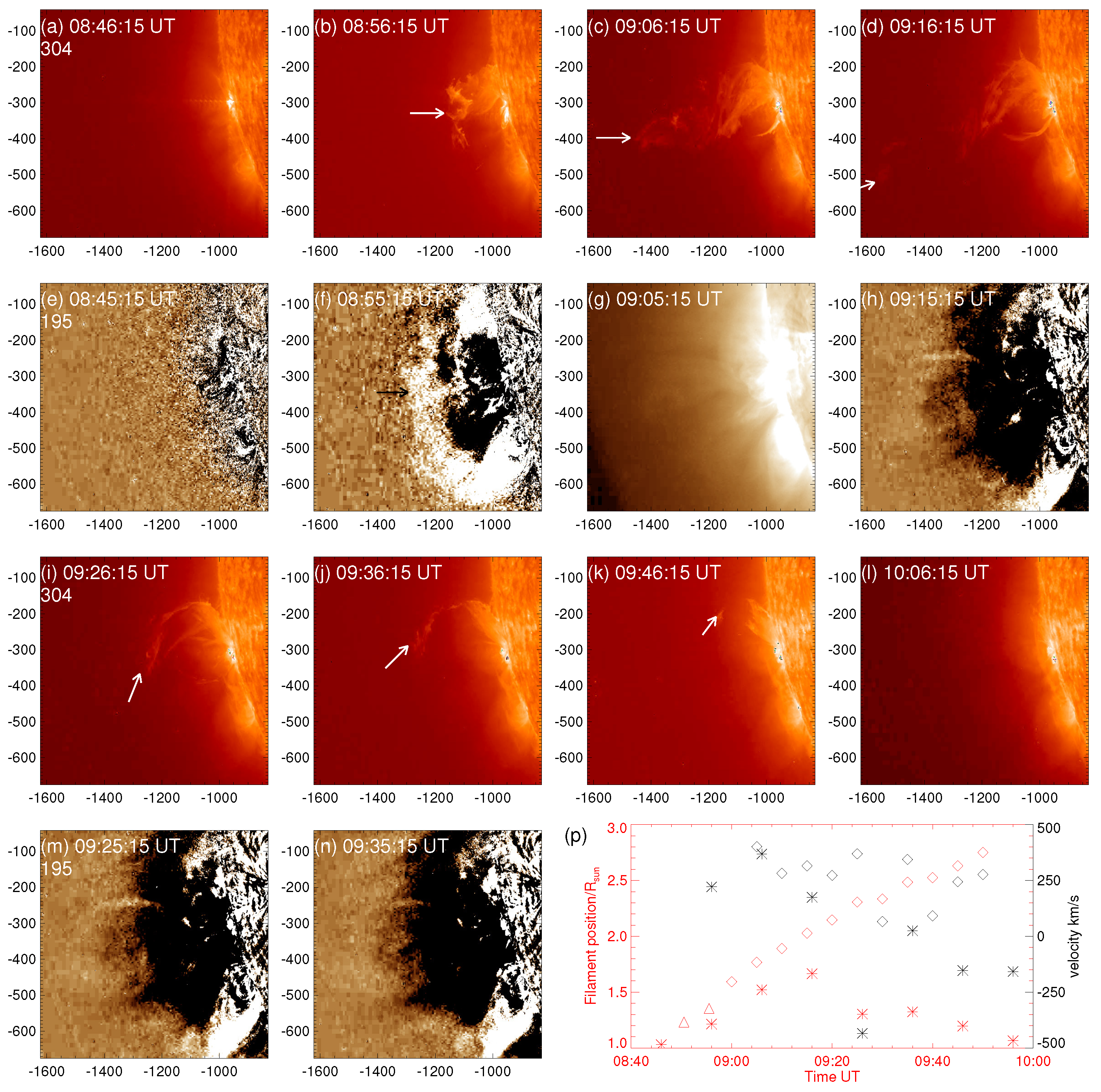
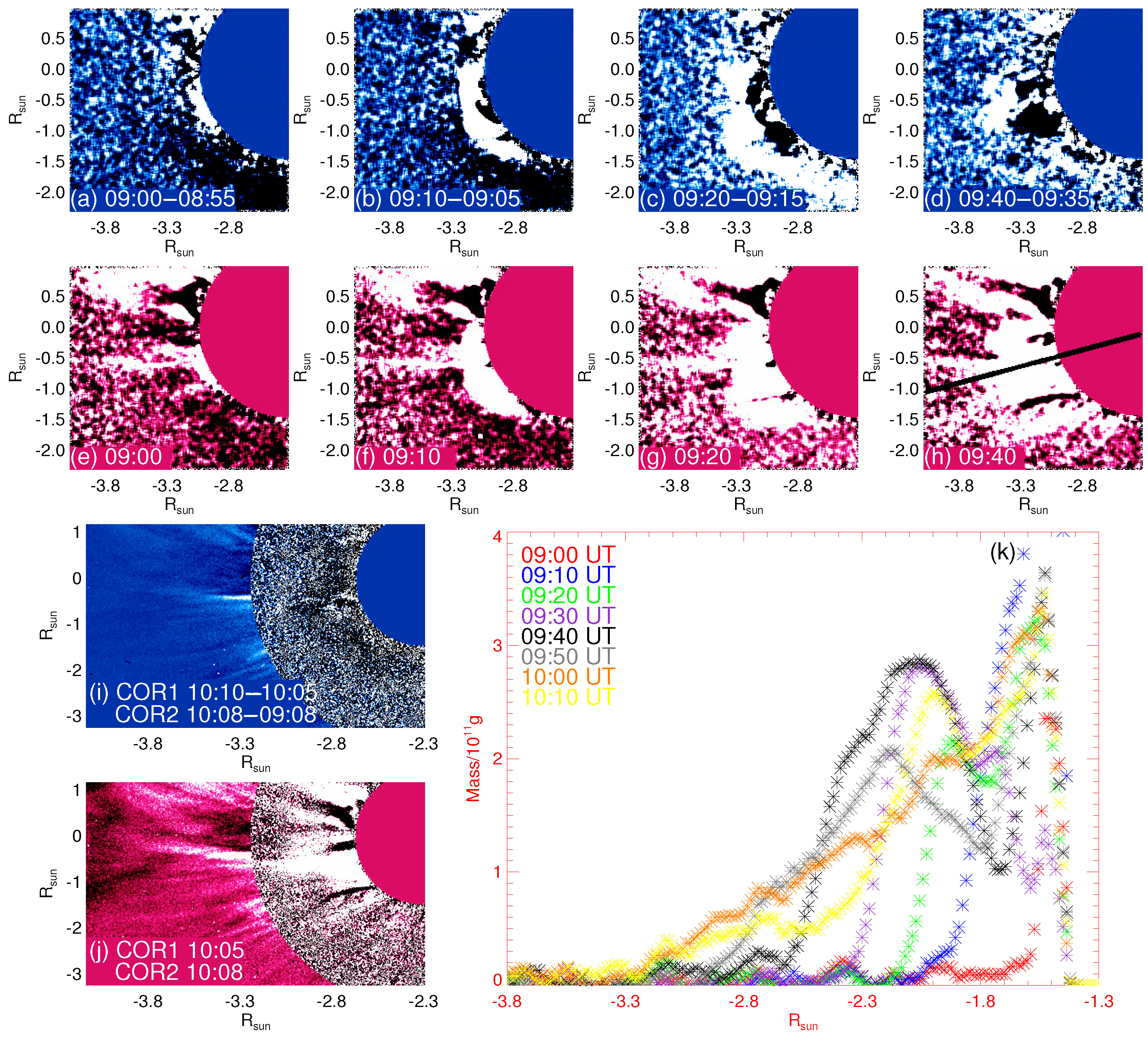

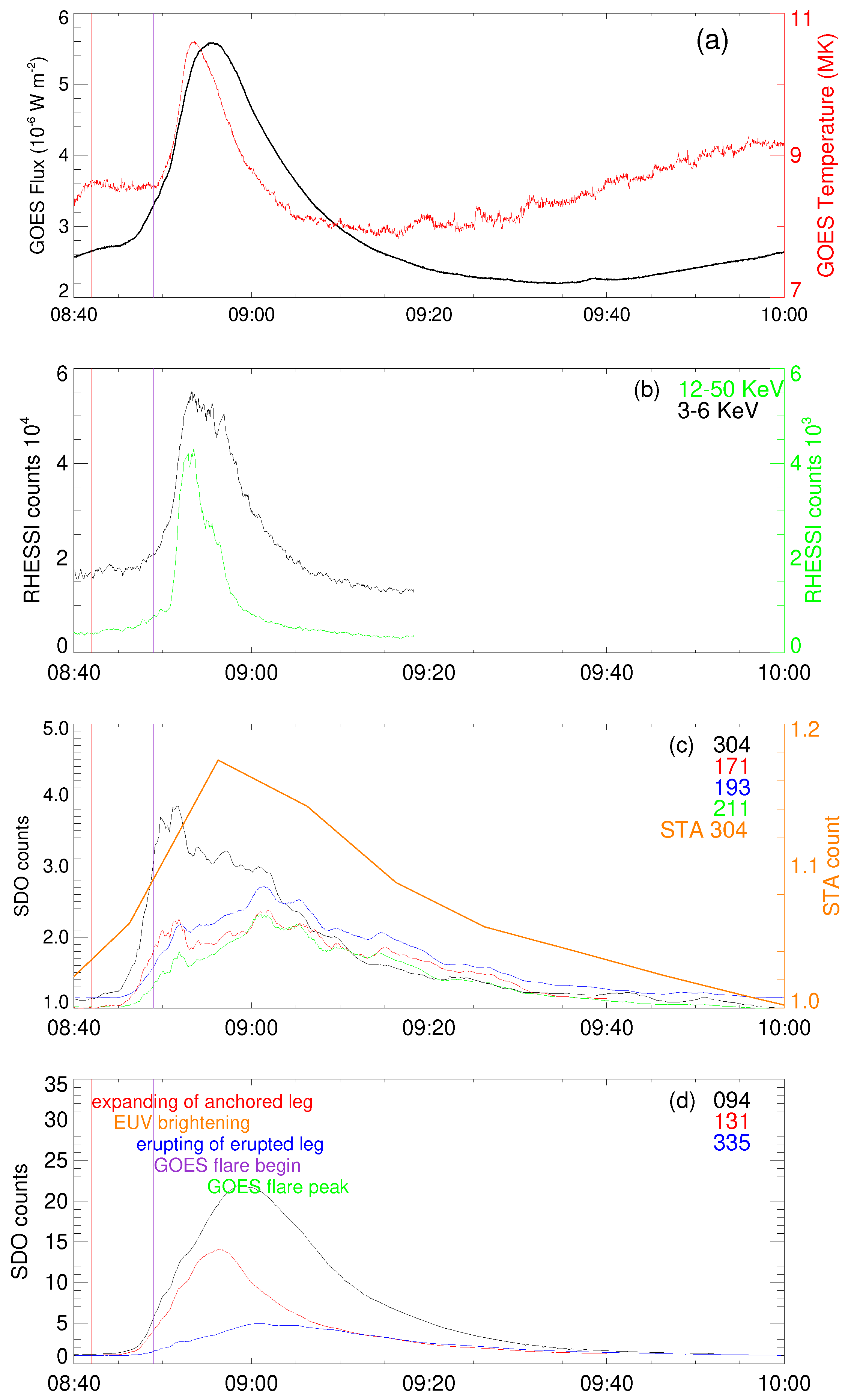
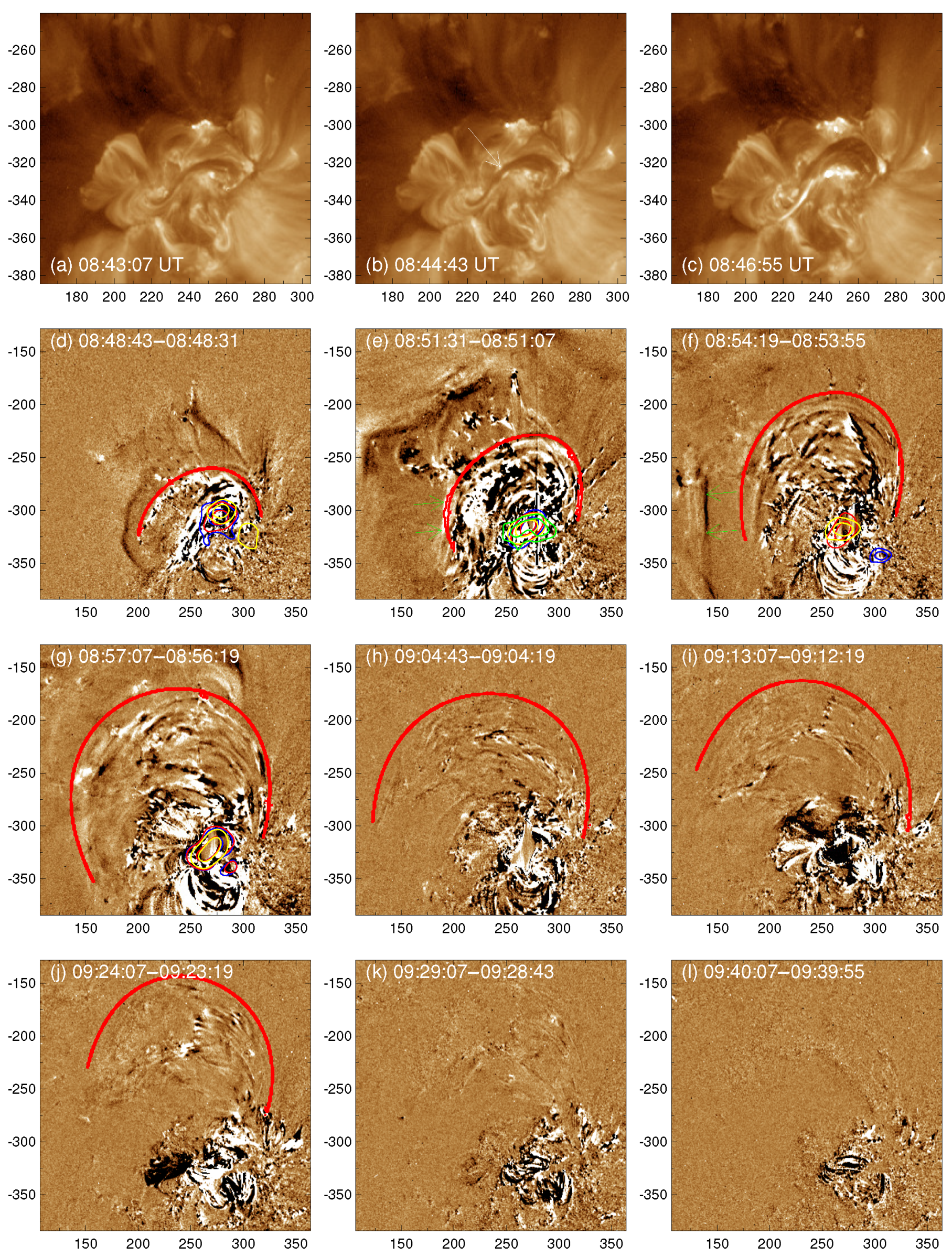
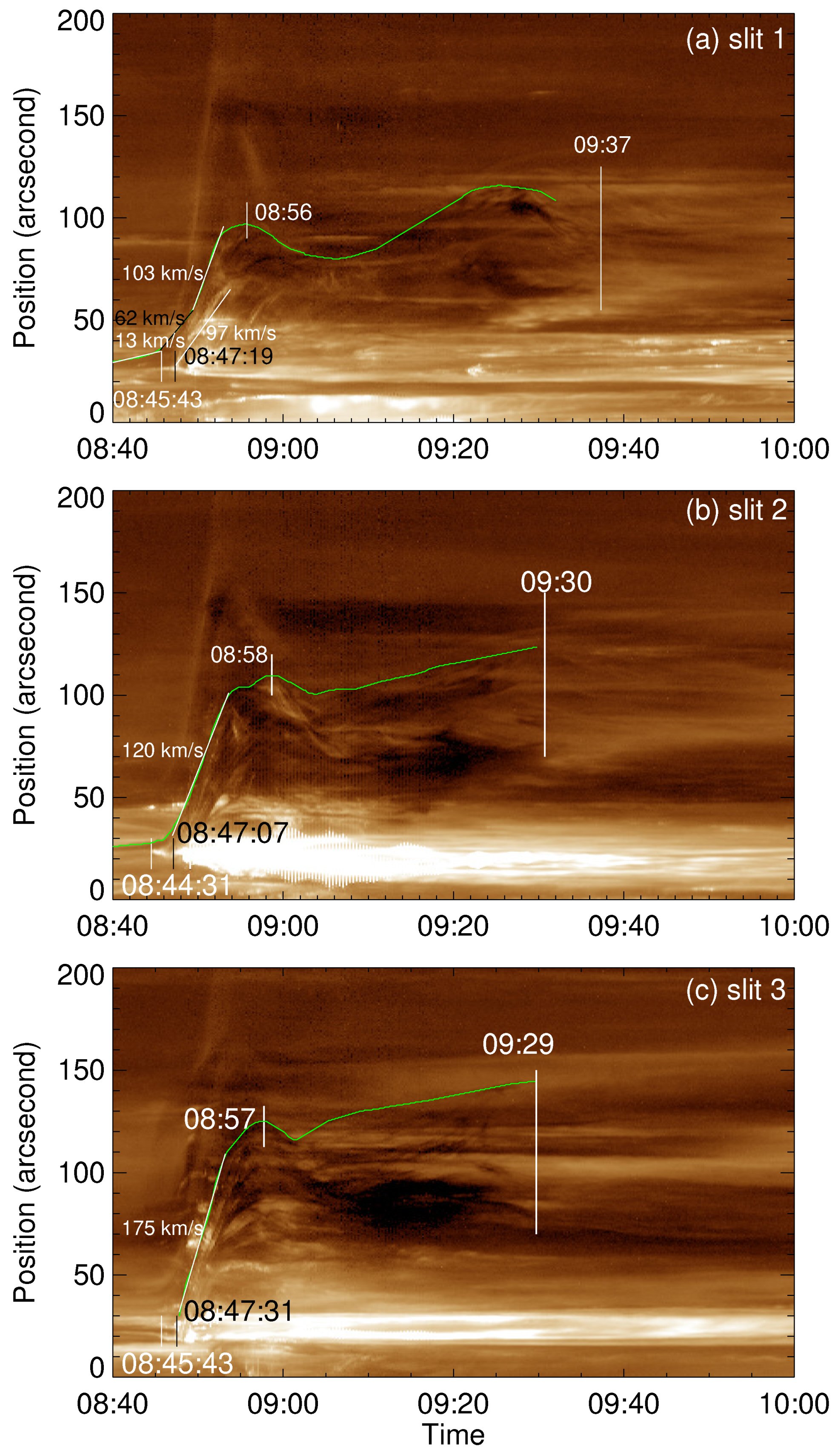
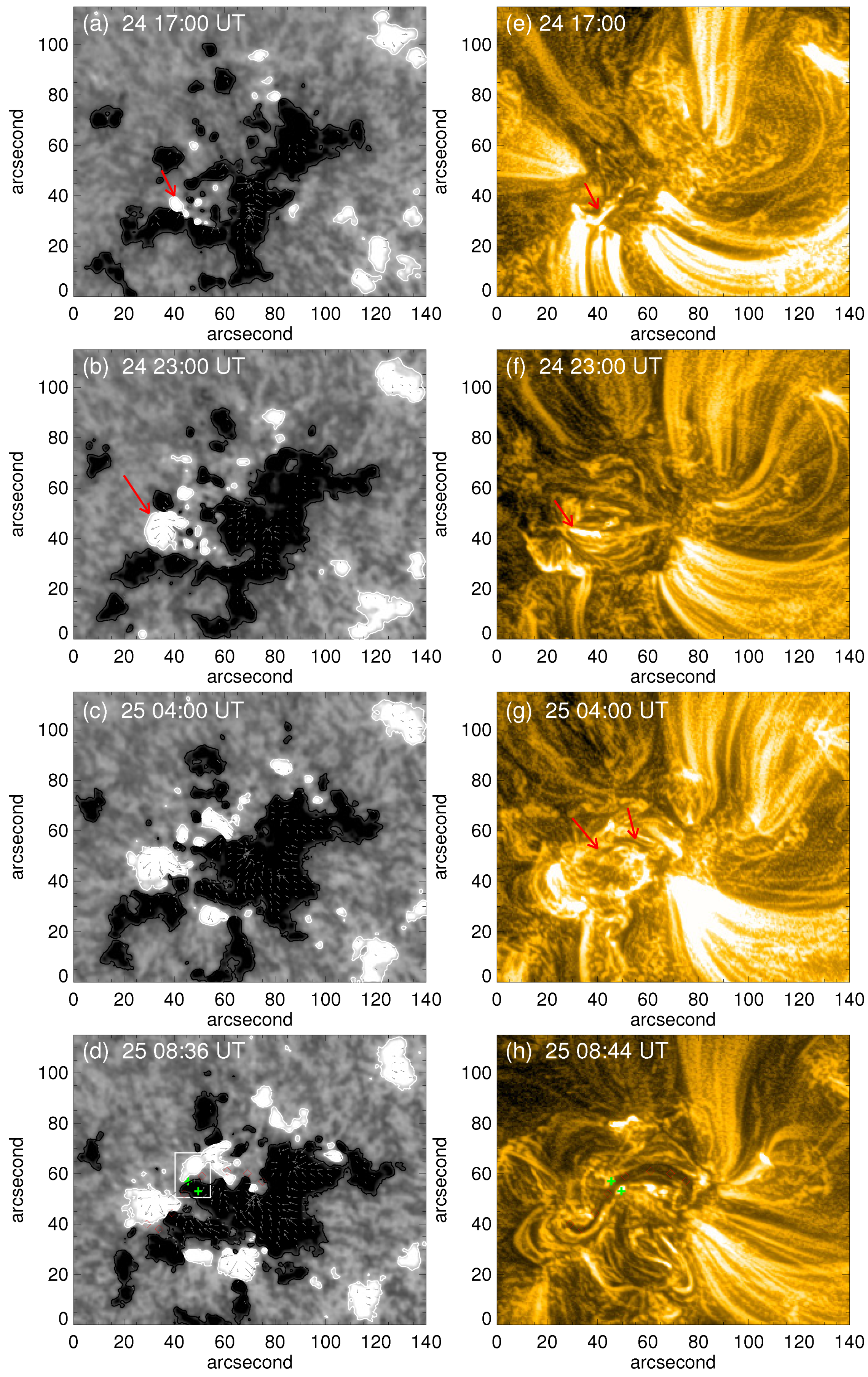
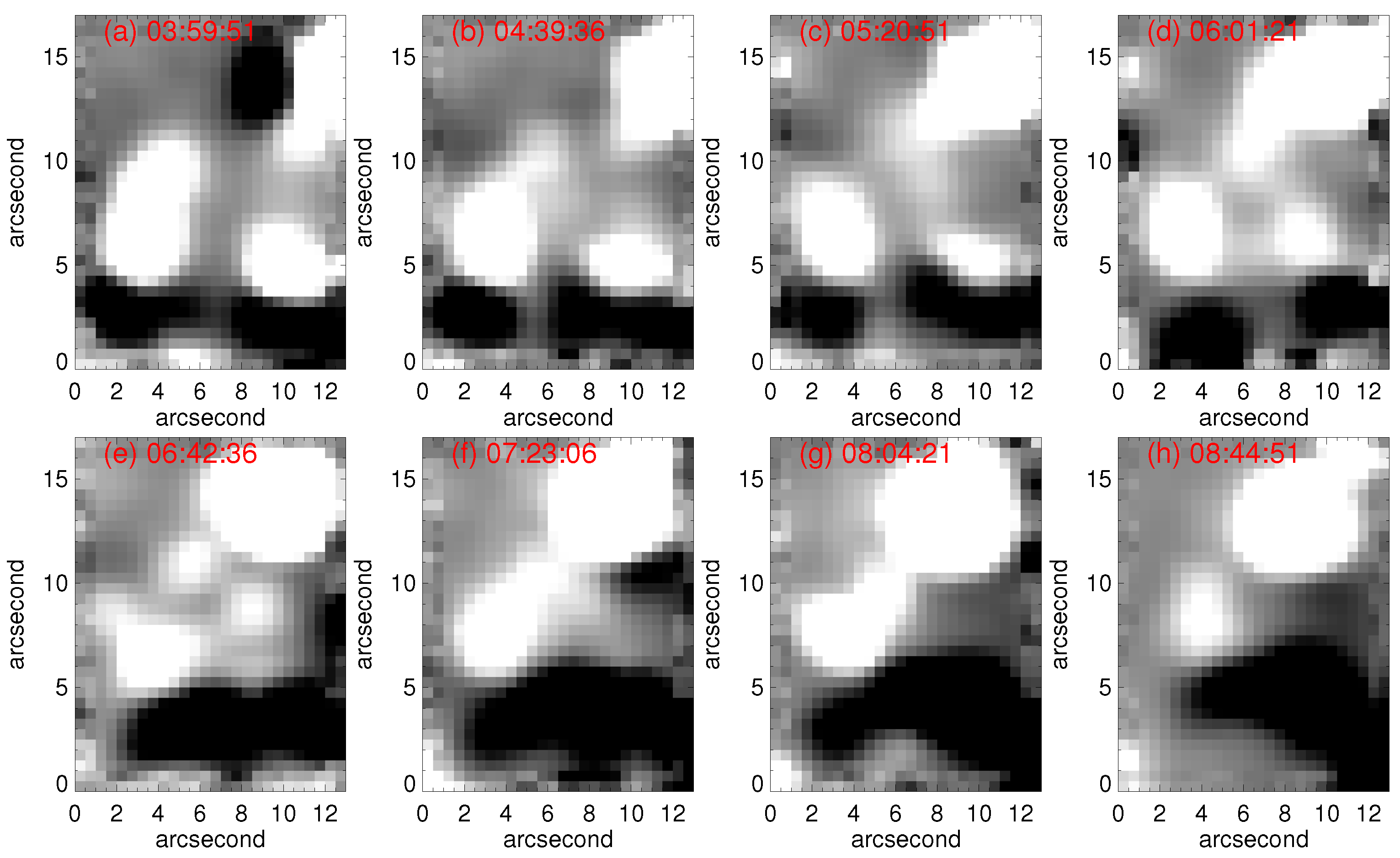
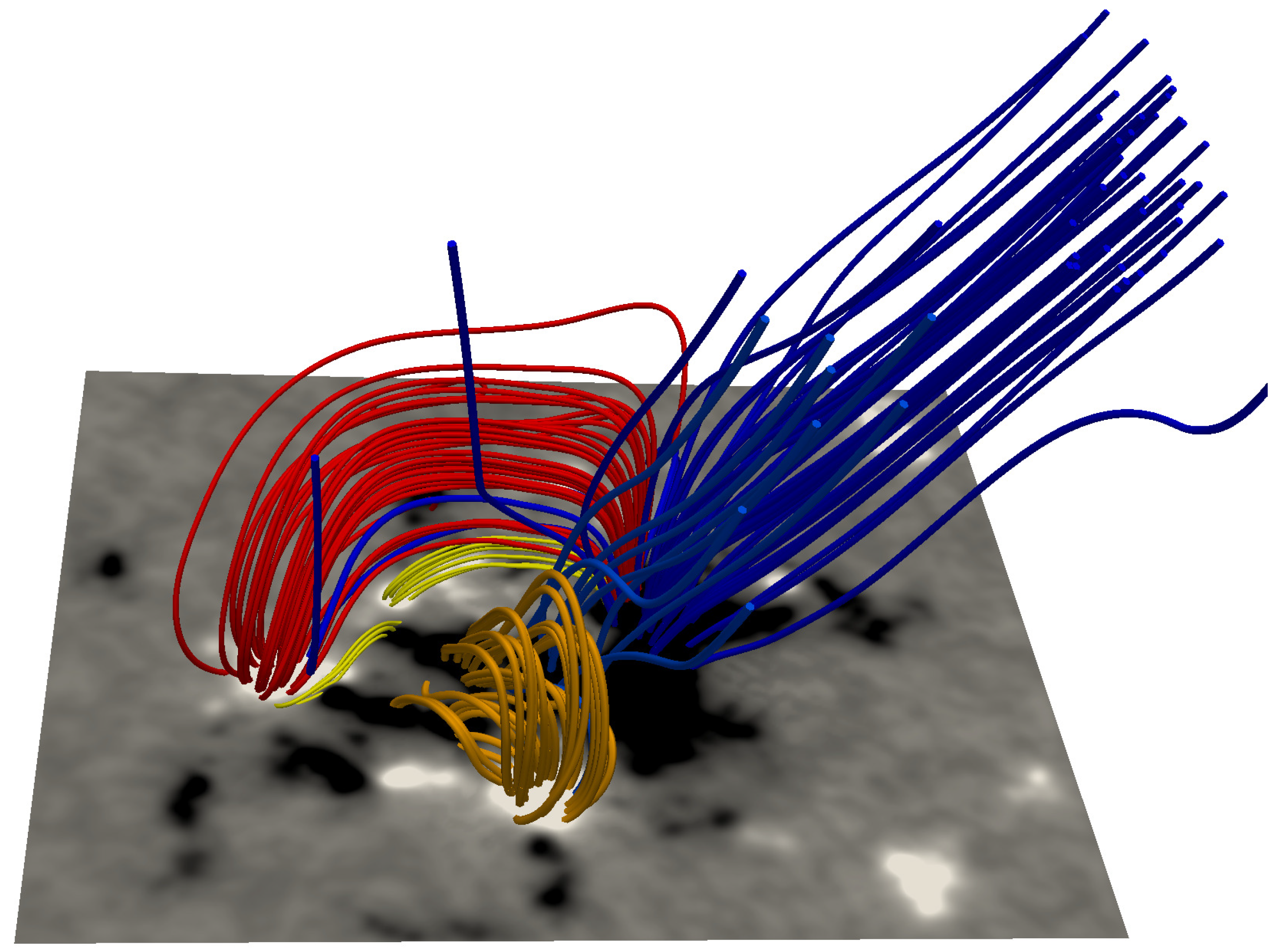

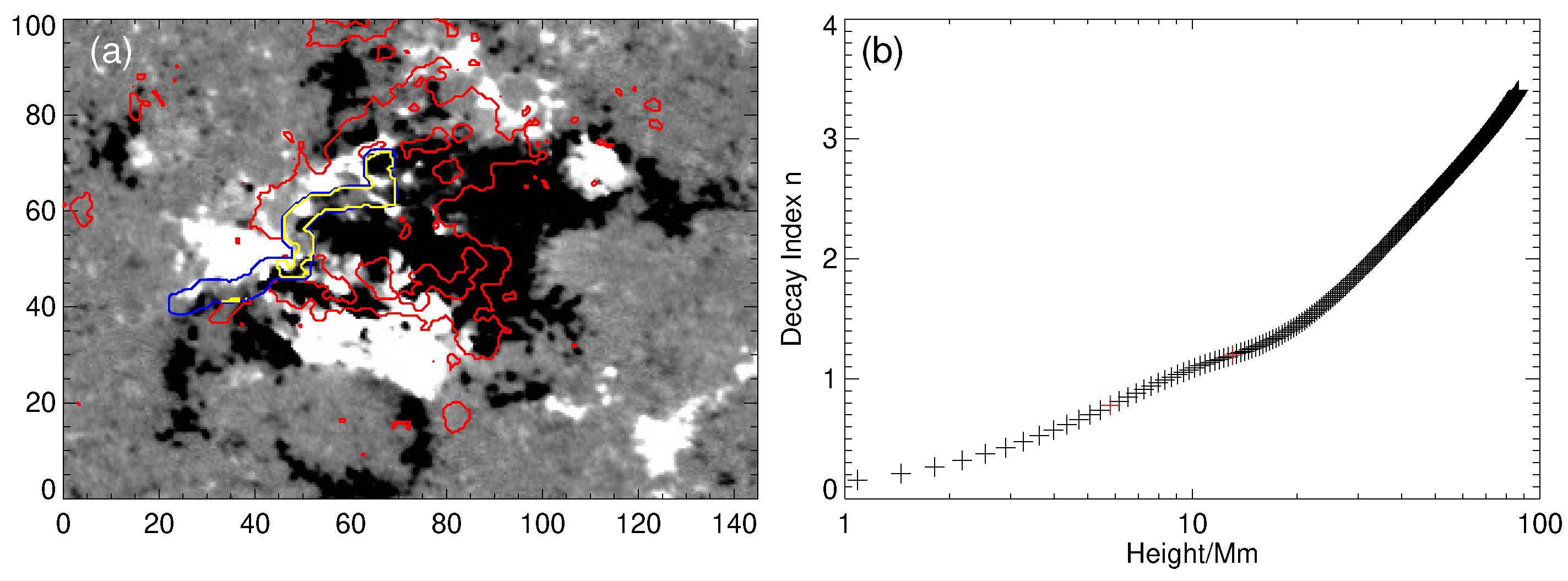
Publisher’s Note: MDPI stays neutral with regard to jurisdictional claims in published maps and institutional affiliations. |
© 2021 by the authors. Licensee MDPI, Basel, Switzerland. This article is an open access article distributed under the terms and conditions of the Creative Commons Attribution (CC BY) license (https://creativecommons.org/licenses/by/4.0/).
Share and Cite
Zhang, Y.; Tan, B.; Tan, C.; Huang, J.; Yan, Y. Multi-Wavelength Observations of a Failed Filament Eruption and Associated Hovered Coronal Mass Ejection. Universe 2021, 7, 405. https://doi.org/10.3390/universe7110405
Zhang Y, Tan B, Tan C, Huang J, Yan Y. Multi-Wavelength Observations of a Failed Filament Eruption and Associated Hovered Coronal Mass Ejection. Universe. 2021; 7(11):405. https://doi.org/10.3390/universe7110405
Chicago/Turabian StyleZhang, Yin, Baolin Tan, Chengmin Tan, Jing Huang, and Yihua Yan. 2021. "Multi-Wavelength Observations of a Failed Filament Eruption and Associated Hovered Coronal Mass Ejection" Universe 7, no. 11: 405. https://doi.org/10.3390/universe7110405
APA StyleZhang, Y., Tan, B., Tan, C., Huang, J., & Yan, Y. (2021). Multi-Wavelength Observations of a Failed Filament Eruption and Associated Hovered Coronal Mass Ejection. Universe, 7(11), 405. https://doi.org/10.3390/universe7110405






